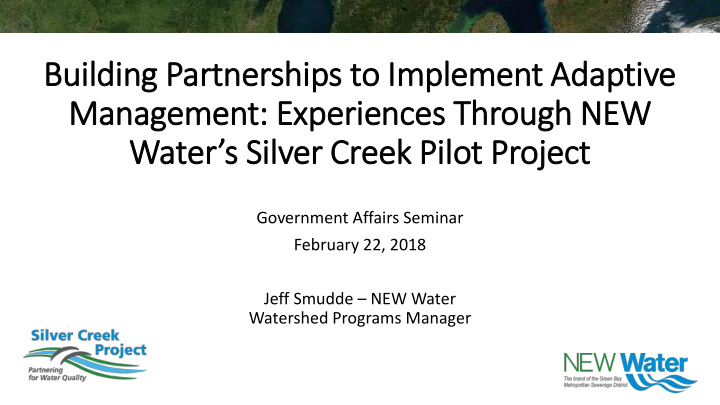



Building P Partner erships t to Implem emen ent A Adaptive e Managem emen ent: E Exper eriences es T Throu ough NEW Water’s Silver C r Creek P Pilot P Proje ject Government Affairs Seminar February 22, 2018 Jeff Smudde – NEW Water Watershed Programs Manager
Partners in Silver Creek Pilot Project
Silver Creek Pilot Project – From the Beginning 2015 – Watershed Inventory 2014 – Project Kickoff • Comprehensive field evaluations • Developed project partners • Arc GIS tablet application • Water quality sampling • Conservation planning meetings • Soil sampling • Developed conservation and • Stream surveys enhanced nutrient mgmt. plans
Silver Creek Pilot Project – 2016 & 2017 • Water quality monitoring • Field planning • Cost share agreements • Best Management Practices (BMPs) installation • Filter strips (buffers) • Critical area plantings • Grassed waterways • Cover Crops • Residue Management • Etc. • BMP Verification • Coordination, coordination, coordination….
Cover Crops • 2015 – 30% winter cover • 2016 – 70% winter cover • 2017 – 85% winter cover
Grassed Waterway Project Aug 31, 2016 Oct 9, 2017 Silver Creek
Filter Strip Projects Dec 1, 2017 Aug. 23, 2017
Water and Sediment Control Basins (WASCOB) Oct. 9, 2017 June 13, 2017
Cover r Crop Interseed eeder er
Wetland Restoration Efforts 7 Wetland Basins 45 Wetland Acres 150 Acre Wetland Complex 650 Acre Drainage Area
Managed Grazing Operation
Program Organization • NEW Water’s Hands-On Leadership at the Field Level • Consultant • Assists with project coordination • Provide technical expertise in areas such as GIS • Independent Agronomists • Work with landowners on crop planning and NMPs • Provide a valuable insight to farming operations • County Land Conservation Staff • Delivers cost share agreements, design and install of practices, verification, and inspection • One staff position funded by NEW Water • Provide conservation expertise and technical resource to land owners and growers
Partners in Silver Creek Pilot Project
Partners in Silver Creek Pilot Project
Observations and Lessons Learned • Agronomists are a critical asset in opening lines of communication with landowners and growers. • Identifying growers that are leaders in the watershed helps build support • Technical staff, working with landowners/growers will get things done • Geographic situations pose unique challenges and opportunities for Adaptive Management • Engaging DNR and EPA staff led to development of a Memorandum of Understanding (MOU) to provide clarity beyond guidance • Local social and economic climate will drive how a watershed program is designed
Jeff Smudde, NEW Water Watershed Programs Manager T : (920) 438-1071 E : jsmudde@newwater.us Questions?
Recommend
More recommend